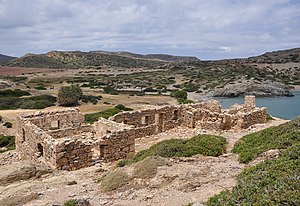
Back Итанос Bulgarian Itanos Catalan Itanos German Ίτανος Greek Itanos Finnish Itanos French Itanos Polish Итан Russian
Ἴτανος | |
 Looking northward from the east akropolis over the beach and bay of Eremoupolis, with Itanos promontory in the background. The ground of the "deserted city" appears bare of vegetation except for overgrown mounds containing structural remains. | |
 Location of ancient Itanos in the municipal unit of Itanos (red area). The yellow area is the remainder of the Municipality of Siteia. | |
| Alternative name | Itanus (Latin) |
|---|---|
| Region | Lasithi Regional Unit Sitia Municipality Itanos Municipal Unit (2011) |
| Coordinates | 35°15′50″N 26°15′47″E / 35.2638°N 26.2630°E |
| Type | Ancient Greek port city |
| Part of | Cape Sidero promontory, NE Crete |
| Area | Maximum territory: 130 km2 (50 sq mi)[1] |
| Site notes | |
| Discovered | 1884[2] |
| Archaeologists | Primarily French School at Athens |
| Condition | Subsurface ruins except for excavated features |
| Ownership | Hellenic Republic |
| Management | 24th Ephorate of Prehistoric and Classical Antiquities (East Crete)[i] |
| Public access | Open |
Itanus or Itanos (Ancient Greek: Ἴτανος)[ii][iii] was a Greek city and port on the northeast coast of ancient Crete, on the promontory which the Romans called Itanum, the neuter form of Itanus, Latin for Greek Itanos.[3] The base of the tripartite northeast promontory, today called Cape Sideros, is still called Itanos or Itano in modern Greek.
Occupation of the promontory began as early as the Final Neolithic, according to the archaeology. The site of the city itself, however, became inhabited in the Geometric Period of the 8th century BC. This city flourished independently of other Cretan powers, playing a leading role in the trade of the region, even becoming, for a while, a protectorate of Ptolemaic Egypt. It became part of the Roman province of Crete, and later Christian buildings were erected. For unclear reasons it was abandoned in the 7th century AD after a life of about 1400 years.[4] The location was lost. Archaeologists were able to locate it in the 19th century. Recently it has become a subject in ground-breaking technologies of sub-surface surveying.
Some of the ruins of the classical and early Christian city are now visible in the elevations around Itanos and Eremoupolis Beaches, in the modern municipal unit of Itanos, of Sitia municipality. The east akropolis of the city was on the headland between the two beaches. The beach shown as Eremoupolis could not have appeared then as it does now, but the details have not yet been investigated scientifically. Itanos Beach on the other side went 100 yards further inland and was the deep channel of the harbor. Apparently, however, the east akropolis was not high enough or isolated enough to be a defensible fort.
Cite error: There are <ref group=lower-roman> tags or {{efn-lr}} templates on this page, but the references will not show without a {{reflist|group=lower-roman}} template or {{notelist-lr}} template (see the help page).